I have 15 features with a binary response variable and I am interested in predicting probabilities than 0 or 1 class labels. When I trained and tested the RF model with 500 trees, CV, balanced class weight, and balanced samples in the data frame, I achieved a good amount of accuracy and also good Brier score. As you can see in the image, the predicted probabilities values of class 1 on test data are in between 0 to 1.
Here is the Histogram of predicted probabilities on test data:
with majority values at 0 - 0.2 and 0.9 to 1, which is much accurate. But when I try to predict the probability values for unseen data or let's say all data points for which value of 0 or 1 is unknown, the predicted probabilities values are between 0 to 0.5 only for class 1. Why is that so? Aren't the values should be from 0.5 to 1?
Here is the histogram of predicted probabilities on unseen data:
I am using sklearn RandomforestClassifier in python. The code is below:
#Read the CSV
df=pd.read_csv('path/df_all.csv')
#Change the type of the variable as needed
df=df.astype({'probabilities': 'int32', 'CPZ_CI_new.tif' : 'category'})
#Response variable is between 0 and 1 having actual probabilities values
y = df['probabilities']
# Separate majority and minority classes
df_majority = df[y == 0]
df_minority = df[y == 1]
# Upsample minority class
df_minority_upsampled = resample(df_minority,
replace=True, # sample with replacement
n_samples=100387, # to match majority class
random_state=42) # reproducible results
# Combine majority class with upsampled minority class
df1 = pd.concat([df_majority, df_minority_upsampled])
y = df1['probabilities']
X = df1.iloc[:,1:138]
#Change interfere values to category
y_01=y.astype('category')
#Split training and testing
X_train, X_valid, y_train, y_valid = train_test_split(X, y_01, test_size = 0.30, random_state = 42,stratify=y)
#Model
model=RandomForestClassifier(n_estimators = 500,
max_features= 'sqrt',
n_jobs = -1,
oob_score = True,
bootstrap = True,
random_state=0,class_weight='balanced',)
#I had 137 variable, to select the optimum one, I used RFECV
rfecv = RFECV(model, step=1, min_features_to_select=1, cv=10, scoring='neg_brier_score')
rfecv.fit(X_train, y_train)
#Retrained the model with only 15 variables selected
rf=RandomForestClassifier(n_estimators = 500,
max_features= 'sqrt',
n_jobs = -1,
oob_score = True,
bootstrap = True,
random_state=0,class_weight='balanced',)
#X1_train is same dataframe with but with only 15 varible
rf.fit(X1_train,y_train)
#Printed ROC metric
print('roc_auc_score_testing:', metrics.roc_auc_score(y_valid,rf.predict(X1_valid)))
#Predicted probabilties on test data
predv=rf.predict_proba(X1_valid)
predv = predv[:, 1]
print('brier_score_training:', metrics.brier_score_loss(y_train, predt))
print('brier_score_testing:', metrics.brier_score_loss(y_valid, predv))
#Output is,
roc_auc_score_testing: 0.9832652130944419
brier_score_training: 0.002380976369884945
brier_score_testing: 0.01669848089917487
#Later, I have images of that 15 variables, I created a data frame out(sample_img) of it and use the same function to predict probabilities.
IMG_pred=rf.predict_proba(sample_img)
IMG_pred=IMG_pred[:,1]

